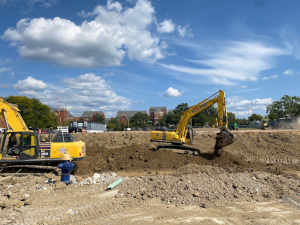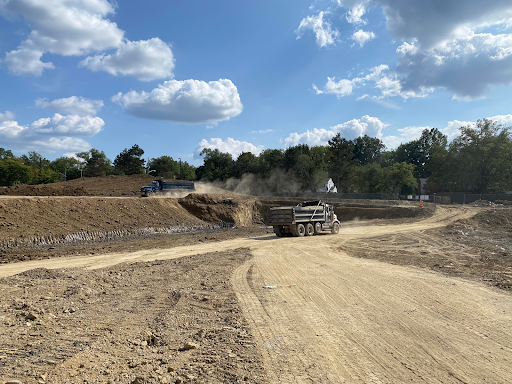In 2020, John Carroll University launched a construction spree, overhauling its campus with various renovations from the Corbo Fitness Center to breaking ground on a new athletic fieldhouse. With 16 completed projects and two major ones currently underway, the university is pursuing its “Building Inspired Futures” vision. The John Carroll community is witnessing the biggest construction boom since the early 2000s. A crucial question remains unanswered amidst climate change and Laudatio Si’ from Pope Francis: are these construction projects environmentally sustainable in our current climate-conscious era?
Rev. James T. Bretzk, Professor of Theology at JCU, said that the Pope outlined “the importance of an integral approach to ecology, and to this end, he proposes a vision of broad involvement and cooperation in virtually all levels of human society.” Bretzke said, “I believe that John Carroll University in its various policies, protocols, building and maintenance would get high marks from the Pope.”
Dr. Edward Peck, Vice President of Mission and Identity at JCU, emphasized the University’s “Blue and Gold Make Green” sustainability program and its Laudato Si’ action plan. Peck shared numerous ways JCU practices sustainability outside construction, like composting food waste and divesting itself of any investments in oil. Peck highlighted how all parts of the University are working together to take better care of the Earth.

Nevertheless, sustainable construction stands as a linchpin in the broader endeavor of environmental preservation, given the inevitability of constructing and renovating structures. In an age where industries grapple with combating climate change, JCU’s commitment to sustainable construction and fostering an environmentally conscious campus appears genuine, but a critical gap remains.
With the demolition of Millor Hall complete, JCU began its most ambitious project since the construction of the $66 million Dolan Center for Science and Technology in 2003: the new Athletic Wellness & Event Center.
Jeremiah Swetel, Assistant Vice President of Facility and Auxiliary Services at JCU and co-chair of the Laudato Si’ committee, noted that JCU recycled 80% of the materials from the demolition of Millor Hall and it purchases 100% of its electricity from renewable energy sources. These are commendable efforts by the university, however, there is a shocking lack of data on the carbon footprint of any of its construction projects.
Swetel said, “Truly understanding the carbon footprint of each one of our buildings is something that we’re still trying to wrap our arms around.”

Swetel explained that with all of these projects, sustainability and the environment are at the forefront of conversations. Swetel explained that the university “looks at all opportunities to be as environmentally friendly as we can,” but “construction by its very nature is a very disruptive thing.”
Supply chain emissions are a crucial aspect of an accurate carbon footprint. Swetel noted that “the burden [that] the sustainability industry, as a whole, has to overcome is…how do we sustainably get those materials to the project site?” He emphasizes that there is a cost to bring materials to construction sites
“There are a lot of fossil fuels used…to get stuff here. And then even in the production of some of the material, there is energy use, and a carbon footprint,” said Swetel.
Regardless, JCU attempts to achieve some level of LEED certification from the U.S. Green Building Council (USGBC) with every construction project. LEED Certification has four tiers with each tier carrying a minimum number of points. Certification is given out based on adherence to prerequisites that address carbon, energy, water, waste, transportation, materials, health and indoor environmental quality. To Swetel, the difference between these tiers is the “level of commitment to continuously monitoring the building.”
With all undertakings, Swetel highlights that “every material..for the project has to be approved for John Carroll to meet certain standards. And they have to fall in line with how we’re tracking for LEED certification.”
Swetel also explains that sustainable construction does necessarily correlate with increased costs. He feels there is “a general kind of misconception that, to have a green building means that it’s gonna cost more,” when in reality, if sustainability is incorporated into the plans early on it can be fairly affordable.
Yet, with over $30 million spent on renovations for Pacelli and Dolan Halls, JCU did not submit applications for LEED certification due to budgetary constraints. This is concerning because the buildings were designed to meet LEED Silver and Swetel says “there’s not a lot you need to do” to achieve the rank because of its standardization.
Despite this, Swetel believes that they can achieve LEED Gold, the second-highest certification, with the new fieldhouse.

The administration is undoubtedly committed to sustainable construction; nevertheless, the lack of data on the carbon footprint of these projects and how the Dolan and Pacelli Hall budgets missed their marks is concerning. While JCU may have some data on this in the future, questions remain as to whether it will be holistic. Will it include emissions from the transportation of materials? Will financials allow John Carroll to continue to pursue environmentally friendly projects? In the meantime, it remains unclear how sustainable JCU truly is.



Carrie Buchanan • Oct 17, 2023 at 9:51 am
This is really good journalism. Well done Tate Farinacci!
Tate Farinacci • Oct 18, 2023 at 6:30 pm
Thank you!
Matt Jurkiewicz • Oct 16, 2023 at 3:59 pm
Very interesting and thought provoking article. Subscribed